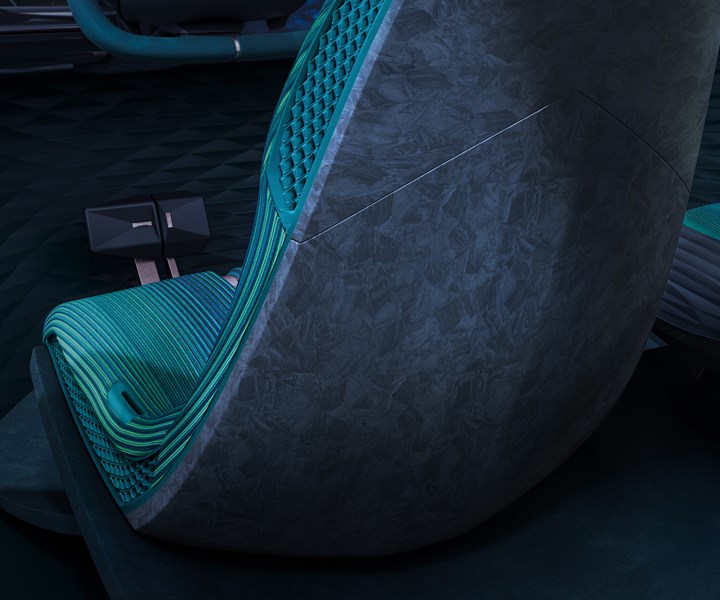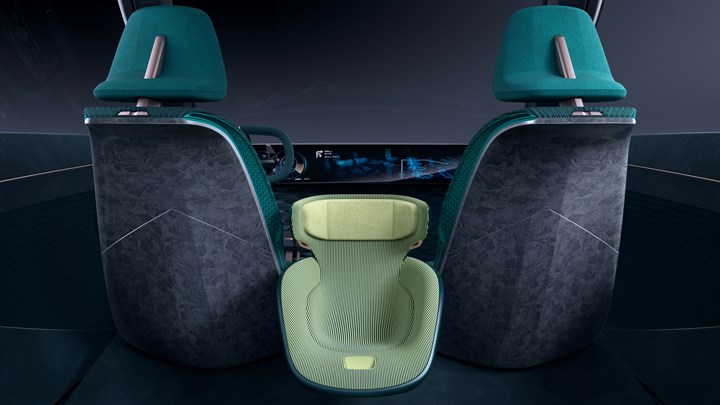Thermoplastic composites incorporated into vehicle seatback concept
Covestro’s Maezio carbon fiber-reinforced thermoplastic composites were used to develop a lightweight, sustainable seatback concept for a Chinese car manufacturer.

Source | Covestro
Covestro (Leverkusen, Germany) announced on Jan. 14 that it has partnered with the Research and Development Center of Guangzhou Automobile Group Co. Ltd. (GAC R&D Center; Guangzhou, China) to develop a lightweight composite seat back for the car manufacturer’s latest electric concept car, the ENO.146.
The ENO.146 is designed to be a highly aerodynamically efficient vehicle, with a drag coefficient of only 0.146 and a New European Driving Cycle (NEDC) range of 1,000 kilometers. Efforts to reduce vehicle weight and increase sustainability have resulted in the selection of Covestro’s Maezio carbon fiber-reinforced thermoplastic composite (CFRTP) material for the backrests of the concept car’s front seats. Compared to typical metal constructions, the CFRTP seat backrest results in estimated weight savings of up to 50%.
“Seats in the passenger compartment are an ideal target for weight savings, as they are among the heaviest parts there,” says Lisa Ketelsen, head of Covestro’s thermoplastic composites business. “Fiber-reinforced composites are the ideal material for lightweight automotive construction, but Maezio can further simplify molding and streamline the manufacturing process.”
According to Covestro, fittings and other attachments add to the complexity of production and assembly for seats with metal backrests. Because Maezio is a thermoplastic material, parts and functions can be consolidated by injection molding processing. Functional structures are incorporated into the mold for shaping the backrest, reducing the number of parts and materials.

Source | Covestro
The backrest also needed to meet the aesthetic and sustainability goals of the vehicle interior, which was designed with green colors and patterns reminiscent of nature and to incorporate sustainable or recyclable materials. The Maezio material is able to be cut and shaped into the desired marble-like pattern, fitting aesthetic requirements, and can be reused at the end of its service life, which suited the team’s sustainability needs.
“Mobility trends such as electrification and autonomous driving are redefining the role and function of car interiors,” says Zhang Fan, vice president of the GAC R&D Center. “There is a growing need for material solutions that are lightweight and sustainable while opening up ways to create new user experiences ranging from visual to tactile feedback.”
The vehicle recently made its debut at the Guangzhou International Automobile Exhibition.
Related Content
-
Infinite Composites: Type V tanks for space, hydrogen, automotive and more
After a decade of proving its linerless, weight-saving composite tanks with NASA and more than 30 aerospace companies, this CryoSphere pioneer is scaling for growth in commercial space and sustainable transportation on Earth.
-
Recycling end-of-life composite parts: New methods, markets
From infrastructure solutions to consumer products, Polish recycler Anmet and Netherlands-based researchers are developing new methods for repurposing wind turbine blades and other composite parts.
-
Daher CARAC TP project advances thermoplastic composites certification approach
New tests, analysis enable databases, models, design guidelines and methodologies, combining materials science with production processes to predict and optimize part performance at temperatures above Tg (≈150-180°C) for wing and engine structures.

.jpg;width=70;height=70;mode=crop)














